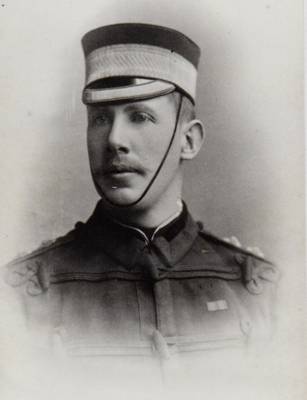
Lieutenant Colonel
JAMES MOLESWORTH WADE
Royal Engineers
by
Lieutenant
Colonel (Retired) Edward De Santis, MSCE, PE, MInstRE
U.S. Army Corps of Engineers
Ó 2020.
All Rights Reserved.

Figure 1. James Molesworth
Wade as a Lieutenant, c. 1887.
(Photograph courtesy of the Royal Engineers Library)
1. INTRODUCTION
The principal references
used in the preparation of this narrative were from a number of sources.
They include census records, official registries in the United Kingdom,
medal rolls, family trees, Army Lists, Royal Engineers Lists and The London
Gazette. A document of significant
value was provided by the Librarian of the Royal Engineers.
This document gave specific dates regarding Wade’s assignments and
promotions. All sources are
contained in the REFERENCE section at the end of the narrative and are cited
throughout in the ENDNOTES. Every
effort has been made to accurately portray the life and military service of
Lieutenant Colonel Wade.
Family
Information
James Molesworth Wade’s father, James Herne Wade (1830-1908), was born in Beccles, a market town in the county of Suffolk, approximately 100 miles northeast of London. His mother, Catherine Molesworth (1834-1911), was born in Brixton, then a part of the county of Surrey. She was the daughter of Colonel St. Aubyn Molesworth (1800-1858), an officer in the Royal Engineers.[i] He retired on full pay on the 17th of February 1857.[ii]
James Henry Wade was commissioned in the 53rd (Shropshire) Regiment of Foot and served in the Crimean war with the 90th Light Infantry at the siege and fall of Sebastopol from the 4th of December 1854. He was with the storming party at the assault of the Redan on the 8th of September 1855 and was severely wounded. For his part in the action he was mentioned in despatches. His service in the Crimean war earned him the Crimean War Medal with clasp [SEBASTOPOL], the Turkish Crimea Medal, the Sardinia Crimea Medal and the Turkish Order of Medjidie, 5th Class. He later served during the Indian Mutiny, 1857-1858, with the 53rd Regiment of Foot and was with Havelock’s column in the actions of the 21st and 23rd of September 1857 during the relief of Lucknow and the subsequent defence of Lucknow. He was mentioned in despatches for his actions in these operations. He later served with Outram’s Force at the Alumbagh, including the repulse of numerous attacks on the position from November 1857 to March 1858. He later took part in the final operations in Oude where he gained a brevet promotion to Major. In April of 1859 the 53rd Foot, under Brigadier Walker, struck the final blow on the survivors of the Indian regiments that had perpetrated the massacres at Cawnpore.
For his service in India Major James Henry Wade was awarded the Indian Mutiny Medal with clasps [LUCKNOW] and [DEFENCE OF LUCKNOW] and the credit of a year’s service for his participation in the operations at Lucknow. He returned home with his regiment in 1860. Wade attained the rank of Lieutenant Colonel before he retired from the Army.[iii]
Early
Life
James Molesworth Wade was born on the 3rd of October 1862 at 123 High Street in Portsmouth Town, County of Southampton.[iv] At the time of his birth his father was a Major and was still serving in the 53rd Foot. Young James was baptized on the 26th of October 1862 at St. Thomas Church in Portsmouth.
James’ sister, Harriet Lucinda Wade (1865-?) was born in Waterford, Ireland on the 12th of December 1865, probably while her father’s regiment was serving there. His brother, Hender Molesworth St. Aubyn Wade (1867-1903) was born in Exeter, Devonshire on the 26th of November 1867.[v]
The Wade household in 1871 was as shown in the table below:
1871
Census of England
|
Census
Place: Eggbuckland,
Devonshire. |
|||||
|
Name
and Surname of each Person |
Relation |
Marital
Status |
Age |
Profession
or Occupation |
Birthplace |
|
James
H. Wade |
Head |
Married |
40 |
Lt.
Colonel, half pay, late 53rd Regt. |
Beccles, |
|
Catherine
Wade |
Wife |
Married |
37 |
|
[Brixton], |
|
James
M. Wade |
Son |
|
8 |
|
Portsmouth, |
|
Harriet
L. Wade |
Daughter |
|
5 |
|
[Waterford], |
|
Hender
M. St. A Wade |
Son |
|
3 |
|
Exeter, |
|
Harriet
L. Leary |
Servant |
Single |
29 |
Domestic
Servant |
(illegible), |
|
Fanny
Field |
Servant |
Single |
24 |
Domestic |
(illegible), |
|
Charles
Langford |
Servant |
Single |
21
|
Groom
& (illegible) |
Plymouth, |
James entered Dulwich College in 1873 at the age of 10. In July of 1880 he left Dulwich College to attend the Royal Military Academy at Woolwich. This was to be expected since his father and his mother’s father had both served as officers in the Army. His brother, Hender, had also attended Dulwich College, but he left in the same month as his brother James and went to Germany. Why Hender left college to go to Germany has not been uncovered during this research.
Hender returned from Germany and re-entered Dulwich College in September of 1882 where he was in Blew House and won an Exhibition scholarship.[vi] He left Dulwich in July of 1884 to attend the Royal Military College like his brother before him. Hender played for the Woolwich XV in 1885.[vii]
James appears in the 1881 Census of England at the Royal Military Academy in Woolwich. Oddly, the 1891 Census of England shows Lieutenant Colonel (Retired) James H. Wade, age 60, and his wife Catherine Wade, age 57, as boarders at St. George, Hanover Square, London in a lodging house owned by one Louis Degasperi and his wife Marie. In 1891 James was still in India and Hender was serving with the Ordnance Survey and may have been in Ireland at the time of the census. Harriet Wade was 25 years old in 1891 and had married one William Shaw Harriss Gastrell and was living in St. Thomas, Devonshire. The elder Wades, James and Catherine, may have been between residences in 1891, as they appear in their own home again in 1901.
1901 Census of England
|
Census
Place: Littleham, St.
Margaret, Exmouth, Devonshire. |
|||||
|
Name
and Surname of each Person |
Relation |
Marital
Status |
Age |
Profession
or Occupation |
Birthplace |
|
James
H. Wade |
Head |
Married |
70 |
Retired
Lt. Col. 90th L.I.(d) |
Beccles, |
|
Catherine
Wade |
Wife |
Married |
69 |
|
Brixton, |
|
Hender
M. Wade(a) |
Son |
Single |
33 |
Capt.
R.E. Army Off. |
Exeter, |
|
Wallis
F. Gordon |
Servant |
Single |
25 |
Sick
Attendant & Domestic(b) |
Exeter, |
|
Annie
Howell |
Servant |
Single |
41 |
Cook |
Exmouth, |
|
Flora
Haverill |
Servant |
Single |
24 |
Parlour
Maid |
Poundstock,(c) |
TABLE NOTES:
(a) Hender Wade is shown as a Captain in the Royal Engineers, but he is living in his parent’s home in 1901. Given that he died in March of 1903 it may be that he was not serving at the time, but was in fact an invalid due to some illness.
(b) Wallis F. Gordon’s occupation is listed as Sick Attendant and Domestic. This supports the idea that Hender may have been seriously ill and that Gordon was being employed to care for him. See Section 8 for further details on Hender’s life.
(c) The town of Poundstock actually was in Cornwall and not in Devonshire.
(d) This census has Lieutenant Colonel Wade as retired from the 90th Light Infantry rather than the 53rd Regiment of Foot.
3. COMMISSIONING AND
TRAINING
On the 25th of July 1882 James Molesworth Wade, following in the steps of his maternal grandfather, was commissioned a Lieutenant in the Royal Engineers. He was immediately posted to the School of Military Engineering at Chatham, Kent for officer training and he remained at Chatham for two and a half years.[viii]
4.
ASSIGNMENTS AND CAMPAIGN SERVICE
India
(1884-1885)
Lieutenant Wade left Chatham and proceeded to India on the 27th of December 1884. Upon his arrival in India he was posted to Roorkee in Bengal where he served with the 4th Company, Bengal Sappers and Miners. The company was commanded by Lieutenant William Alan Cairnes, R.E.[ix] with Lieutenant Francis Henry Kelly, R.E.[x] also serving in the company. This was to be the first of James’ many postings to India.
Burma
(1885-1886)
On the 29th of October 1885 Lieutenant Wade departed Roorkee with his company, arriving in Rangoon, via Calcutta, on the 8th of November. On the 12th of November his company departed Rangoon with a field force of about 9,000 men under the command of Major General H.N.D. Prendergast, CB, VC[xi] The field force advanced up the Irrawaddy River to Mandalay with the mission to depose King Thibaw of Burma.
The background for the British embarking on this expedition is based on the attempts of King Mindon, who tried to modernize the Burmese state and economy, to resist British encroachments into his kingdom. He established a new capital at Mandalay, which he proceeded to fortify. This was not enough to stop the British, however, who claimed that Mindon's son Thibaw Min (who ruled from 1878 to1885) was a tyrant intending to side with the French,[xii] that he had lost control of the country, thus allowing for disorder at the frontiers, and that he was reneging on a treaty signed by his father. The British declared war once again in 1885, conquering the remainder of the country in what was to be known as the Third Burma War resulting in total annexation of Burma.
Wade and his men embarked on three barges that were attached to the river steamer “Shway Myo” and on the 17th of November they arrived at Thayetmayo, only 18 miles from King Thibaw’s frontier.
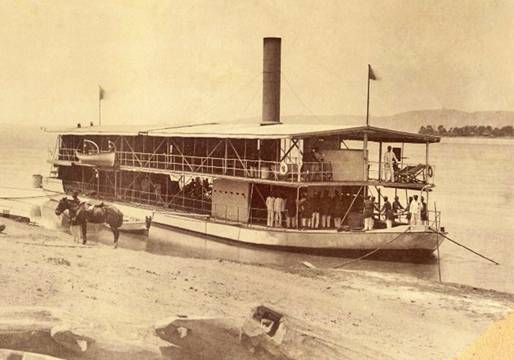
Figure 2. An Irrawaddy River
Steamer, c. 1885.
(Photograph courtesy of Wikipedia)
On the 17th of November British Indian forces under Brigadier General G.S. White had captured the Italian-designed fort at Minhla after unexpectedly fierce resistance from the Burmese garrison. Over a hundred Burmese were killed. The British side was armed for the first time with machine guns (recoil-operated Maxim guns). Wade’s company arrived at Minhla the day after its capture and remained in the fort as part of its garrison.
By the 28th of November the British had surrounded the royal capital in Mandalay. The following day, King Thibaw surrendered to British commander Sir Harry Prendergast and was sent into exile to India, eventually ending the monarchy in Burma.
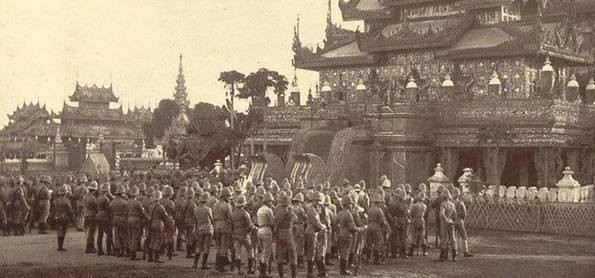
Figure
3. British Troops Surrounding King
Thibaw’s Palace in 1885.
(Photograph courtesy of Wikipedia)
Lieutenant Wade and his company arrived at Mandalay on the 14th of December 1885, two weeks after Thibaw’s surrender. He departed Mandalay on the 18th of December on the Irrawaddy River with General Prendergast and a force of about 1,000 men to meet the threat of a Chinese force massing on the northeast frontier of Burma.
On the 28th of December he and his company took part in operations to seize Shwebo and to occupy Bhamo. This operation took place because after the surrender of King Thibaw, the Burmese Resistance Movement occurred almost immediately after the fall of Mandalay. Due to the rapidity of British advancement up the Irrawaddy River, the bulk of the Burmese army suffered few casualties. Many had not experienced actual fighting. Nevertheless, the issue of the order to surrender on 27th of November 1885 meant that Burmese garrisons south of Mandalay had to disarm without putting up a fight. Soon widespread resistance started to break out in Upper Burma, Lower Burma, the Shan Hills, Kachin Hills and the Chin Hills.
The action at Bhamo was a very important move on the part of Prendergast, as it forestalled the Chinese who had their own claims and border disputes with Burma. Although the king had been dethroned and exiled with the royal family to India, and the capital and the whole of the Irrawaddy was in the hands of the British, bands of insurgents took advantage of the situation to continue an armed resistance which proved very difficult to defeat.
In January of 1886 Wade and his company took part in operations against Kachin dacoits in heavy jungle areas near Karwan in the Ponkan Hills east of Bhamo. These operations lasted until September of 1886.[xiii] In August the command of the 4th Company, Bengal Sapper and Miners had passed to Lieutenant Fenton John Aylmer, R.E.[xiv]
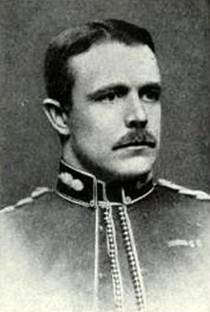
Figure
4. Lieutenant Fenton John Aylmer,
R.E.
(Photograph courtesy of Wikipedia)
While James Wade was involved in these operations in Burma, his brother Hender passed out first from the Royal Military Academy on the 17th of February 1886. He received the Pollock Medal and Sword of Honour, and like his brother he was commissioned a Lieutenant in the Royal Engineers.[xv] Hender was obviously an outstanding cadet and was destined for high rank in the Army. Unfortunately bad health was to cut his life short.
In October of 1886 the British forces began operations to restore order in upper Burma. These operations took Lieutenant James Wade and his company to Pauk, Kanle and Myaing, northwest of Pakokku. Organized resistance on the part of the Burmese ended in December of 1886. See the map at Annex A. More detail of the campaign may be found in Red With Two Blue Stripes by Colonel B.A.H. Parritt, MBE.
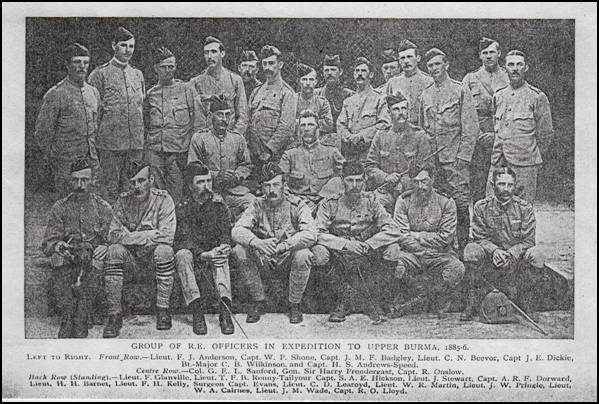
Figure
5. Officers
of the Royal Engineers in Burma, 1885-1886.
Lieutenant
James Molesworth Wade is standing in the back row,
second
from the right.
(See Annex B for a list of all engineer units and officers of the Royal Engineers who served in the campaign)
(Photograph courtesy of The Sapper magazine)
India
(1886-1894)
Wade and his company returned to Roorkee on the 13th of April 1887. On the 13th of July he was awarded the India General Service Medal 1854 with clasp [BURMA 1885-7] for active service in the Third Burma War. The medal roll was prepared at Roorkee on this date by Colonel Sir Bindon Blood,[xvi] the Commandant of the Bengal Sappers and Miners. At the time that the medal roll was prepared, Wade had already left the company and was serving in the Military Works Department in India.[xvii] On the 15th of January 1891, while he was still in India, Lieutenant Wade was promoted to the rank of Captain.[xviii]
Wade’s 1892 posting in the Military Works Department sent him to the Department of Public Works in Simla as an Executive Engineer, 4th Grade. By 1895 he was upgraded to Executive Engineer 3rd Class.[xix]
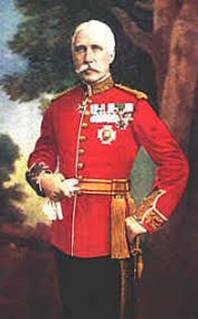
Figure
6. Sir Bindon Blood.
(Photograph courtesy of Wikipedia)
Chatham
(1894-1895)
Captain Wade left India for home on the 2nd of December 1894 and took leave in Europe on the way. Once in England he was posted to Chatham. It may be that his posting was only for a brief period of training and perhaps some home leave. On the 12th of March 1895 he left Chatham to return to India.[xx]
India
(1895-1899)
On his return to India Captain Wade was posted to the Military Works Department again as an Executive Engineer, 3rd Class. During this period public works in the British India Public Works Department consisted of construction and maintenance of buildings and roads and irrigation projects like canals, dams and reservoirs. This is the type of work that Wade was engaged in when he reported for duty Bengal in 1895. He left India for home on the 14th of April 1899.[xxi]
Portsmouth
and Falmouth (1899-1903)
Presumably after a period of leave Captain Wade was posted to Portsmouth on the 1st of June 1899.[xxii] On the 10th of December 1899 he was promoted to the rank of Major;[xxiii] however, the London Gazette of 26 October 1900 antedated his promotion to the 15th of November 1899, thereby giving him an additional 25 days of seniority over his peers.
On the 1st of June 1900 Major Wade was assigned to the Office of the Inspector General of Fortifications[xxiv] and then on the 5th of January 1903 he was posted to Falmouth in Cornwall, probably on the staff of the Commander Royal Engineers (CRE) in that district. During this period the British Army had been involved in the Second Boer War in South Africa. With his campaign experience in Burma in 1885 and 1886 he would have been a prime candidate for active service in South Africa with a field company, but he remained at home during the entire period of the war thereby missing out on campaign medals earned by many of his contemporaries.
Colchester
(1903-1905)
On the 8th of December 1903 Major Wade was assigned as the Officer Commanding the 55th Company, Royal Engineers at Colchester in Essex. He commanded the company until the 28th of February 1905. The company at that time was part of the Eastern Command.
After giving up his command of the 55th Company, Wade remained at Colchester. The Royal Engineers List for February of 1905 shows Wade serving at a Staff Officer to the Commander Royal Engineers, Eastern District at Colchester, with orders pending assigning him to India. The CRE at Colchester at that time was Brevet Colonel W.A.E. St. Clair, R.E.[xxv]
India
(1905-1910)
From March to April 1905 Major Wade is shown as serving in India with no specific assignment.[xxvi] In May of 1905 he was serving as the Assistant CRE in the 2nd (Rawal Pindi) Division of the Rawal Pindi District in the Northern Command, working for Lieutenant Colonel Edward C. Stanton, the CRE.[xxvii] Wade was promoted to the rank of Lieutenant Colonel in the Royal Engineers on the 31st of December 1906
In July of 1907 he was granted leave to England from the 13th of July 1907 to the 27th of July 1908, a rather lengthy period of one year and 14 days. The reason for this lengthy leave is not known, although it may have been associated with a health problem requiring treatment in England for either himself or his wife. In August of 1908 his leave was extended to the 27th of November 1908. Although he was still being carried on the rolls as the Assistant CRE in Rawal Pindi, his place had actually been taken by Major G.S. Cartwright, R.E.[xxviii] while Wade was on this extended leave.
In September of 1908 Wade’s leave was again extended to the 27th of March 1909,[xxix] again with no explanation given for this extended period of leave. It appears that he eventually returned to his posting in India early in 1910.
In January of 1910 Major Wade was serving as the Assistant CRE with the 7th (Meerut) Division in the Meerut District. He was working at the time for Colonel Harold Frank Chesney, RE,[xxx] the Commander Royal Engineers. Sadly, his wife Gwendolen died in Meerut on the 15th of January 1910. Wade continued to serve at Meerut until he returned to England on the 19th of September 1910. From these long and recurring postings to India it seemed that he was becoming an officer of the Indian Army. His pension, upon retirement, would prove this to be true.
Pembroke
Dock (1910-1911)
Upon his return to England Lieutenant Colonel Wade was posted to Pembroke Dock as the Commander Royal Engineers.[xxxi] His headquarters was located at Hobbs’ Point in Pembroke Dock and he was co-located with the 35th (Fortress) Company, R.E. commanded by Captain J.A. Langman. Other officers in the company included Lieutenants J.B. Heron, H.G. MacGeorge and W.G. Lawrie. The Inspector of Works for the district was Honorary Captain G.W. Sawyer.[xxxii]
The 1911 Census of England and Wales shows him living at 6 Norton Tenby in Pembrokeshire, Wales. He is listed as a 48-year old widower living as a boarder in the lodging house of one William James.
Wade served in the capacity of CRE at Pembroke Dock until the 31st of December 1911 when he retired from the Army on an Indian Pension after completing five years of service as a regimental Lieutenant Colonel. Upon his retirement he was placed on the Reserve of Officers list.[xxxiii]
The
Great War (1914-1915)
On the 5th of October 1914 Wade was activated for employment with the Royal Engineers from the Reserve of Officers for service in the Great War of 1914-1915. By April of 1915 he was still serving with the Reserve of Officers and may have had some staff position with the Royal Engineers early in the war. The April 1915 Army shows him under “Royal Engineers” - “Reserve of Officers” - “removed from the Corps and still on the active list” (page 789). The Quarterly Army List, October 1916, page 1999 shows him under “Non-Effective Officers (Retired R.E. with an Indian Pension).” Finally, the Army List, 1924, War Services (page 643) shows him as a “Lieutenant Colonel, retired, Indian Pension. Burmese Expedition, 1885-86, Medal and Clasp.” No record has been found indicating that he actually “was called to active service” during the war and there is no record of him having received any medals for service during the war.
The following sections are presented in tabular form to summarize
Wade’s promotions, appointments, military training and qualifications and
the medals that he was awarded during his time in the Army.
They are provided to give the reader easy access to these aspects of
his military career. The tables
are followed by sections dealing with his marriage, personal information and
post-service life.
a. Promotions: Wade received the following promotions during his time in service:
Date of Promotion or Appointment |
Rank
or Position |
|
25 July 1882 |
Commissioned, Lieutenant, Royal Engineers. |
|
15 January 1891 |
Promoted Captain. |
|
15 November 1899 |
Promoted Major. |
|
31 December 1906 |
Promoted Lieutenant Colonel. |
Date of Appointment |
Position |
|
27 December 1884 |
Field Company Officer, Royal Engineers. |
|
July 1887 |
Staff Officer, Military Works Department. |
|
1 June 1899 |
Staff Officer, Engineer District. |
|
1 June 1900 |
Staff Officer, Fortifications and Works Directorate. |
|
5 January 1903 |
Staff Officer, Engineer District. |
|
8 December 1903 |
Officer Commanding, Royal Engineers Field Company. |
|
19 September 1910 |
Commander Royal Engineers District. |
6. MILITARY TRAINING AND QUALIFICATIONS
a. Military Training: Other than his training as an engineer officer at the School of Military Engineering following his commissioning, Wade does not appear to have received any specialized training during his time in service. During his time at Chatham in 1895 he may have attended a course, but no evidence of this has been uncovered.
b. Qualifications: Wade’s qualifications can be summarized from his appointments above as a company officer and commander of a field company, a staff officer at various levels and a Commander Royal Engineers in a home district.
7. MEDALS, AWARDS AND
DECORATIONS
Due to the nature of his campaign service, Lieutenant Colonel Wade was awarded only one medal during his time in service, the India General Service Medal 1854 with the clasp for [BURMA 1885-7]. As previously indicated, had he participated in the Second Boer War between 1899 and 1902 he could have earned the Queen’s South Africa Medal and the King’s South Africa Medal. Additionally, during the period from 1895 to 1899 when he served in India, there were many small campaigns being fought by the British Army. Had he been posted to a Royal Engineers field company or a company of the Indian Sappers and Miners, he could have earned the India General Service Medal, 1895-1902 with any of the following clasps: [RELIEF OF CHITRAL] [PUNJAB FRONTIER 1897-98] [MALAKAND 1897] [SAMANA 1897] [TIRAH 1897-98] However, this was not the case.
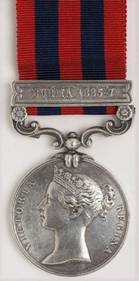
Figure 7. The Medal of
Lieutenant Colonel James Molesworth Wade.
(Photograph from the author’s collection)
8.
MARRIAGE AND ADDITIONAL FAMILY INFORMATION
First
Marriage
James Molesworth Wade married Gwendolen Edith Carter (1883-1910) on the 11th of April 1904 at St, Michaels Church in Teignmouth, Devonshire. Gwendolen accompanied her husband to India in 1905 and unfortunately she died in Meerut on the 15th of January 1910.
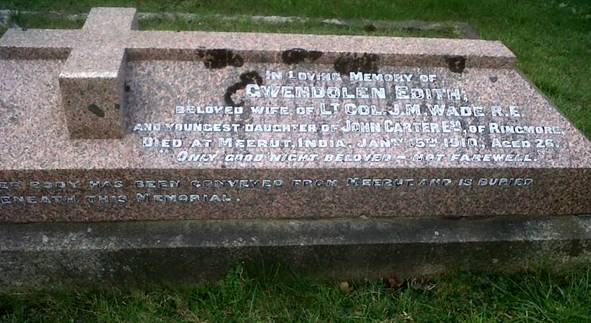
Figure 8. The Grave of
Gwendolen Edith Wade.
(Photograph courtesy of Ancestry.com)
Second Marriage
According to the family tree (by MParker5000), James Molesworth Wade married Johanna Louis Annie Kretzschmar (1892-1957) in December of 1921 in West Ham, Essex. It would appear the James and Johanna may have known each other for some time prior to their marriage (see Children below).
Children
Wade’s family tree (by MParker5000) indicates that James Molesworth
Wade had a son named Gustav Frederick Wade (1912-1986) born on the 9th
of October 1912 in St. Pancras Somers, London.
His mother is shown as Johanna Louisa Annie Kretzschmar, but James and
Annie are not indicated as being married until December of 1921.
G.F. (“Bob”) Wade became a war correspondent in Europe for the BBC
during the Second World War.
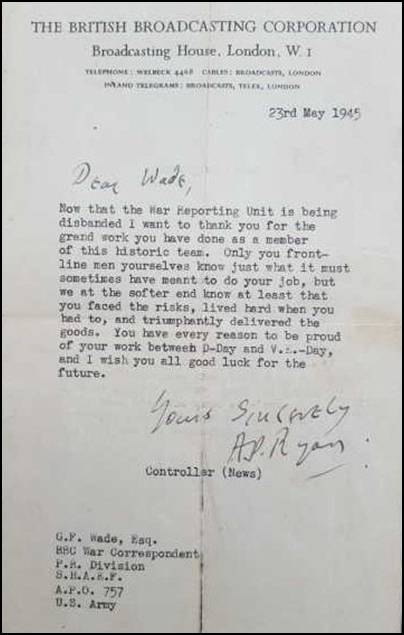
Figure 9. BBC Letter to G.F.
Wade.
(Image courtesy of Ancestry.com)
Gustav Wade was a recording engineer on the Western Front and in Italy as listed in "War Report D-Day to VE-Day" published by the BBC. Following the war (1956) Wade made wildlife recordings in Spain. G.F. Wade died on the 20th of October 1986 in Brighstone on the Isle of Wight.
Parents
James’ father, Lieutenant Colonel James Herne Wade, had retired from the Army by sale on the 25th of March 1869. At the time of his retirement he was serving in the 90th Light Infantry.[xxxiv] He died in St. Thomas, Exeter, Devonshire on the 22nd of September 1908 at the age of 78. He was residing at the time with his wife at 8 Morton Crescent in Exmouth.[xxxv] His will was filed for probate in London on the 27th of November 1908 leaving all his effects to his wife Catherine. His effects amounted to £1497-12s-11d (about $199,100 US in 2020 currency).[xxxvi] James was in India at the time of his father’s death.
Catherine Wade died on the 19th of April 1911, also in St. Thomas, Exeter. She also was residing at 8 Morton Crescent at the time of her death.[xxxvii] She was 77 years of age. Catherine’s will was filed for probate in London on the 26th of May 1911 and her effects were left to her daughter, Harriet Lucinda Gastrell (wife of William Shaw Harriss Gastrell), to one Caroline Ramsey, a widow and presumably a friend of Mrs. Wade, and to James Molesworth Wade, Colonel R.E. Catherine’s effects amounted to £1849-16s (about $260,750 US in 2020 currency). Her effects might have been divided equally among the legatees, although no will has been found to confirm this. It also might be safer to assume that her children, Harriet and James, may have received more than Caroline Ramsay.
Siblings
Harriet
Lucinda Wade
James’ sister Harriet married William Harriss Gastrell (1862-1948) in October of 1890 in St. Thomas, Devonshire. William and Harriet had one child, Katharine Edith Gastrell (1891-1985) who was born in Argentina on the 21st of September 1891. William had been employed as a civil servant and by 1939 he had retired after serving as His Majesty’s Consul General in Paris. William died on the 23rd of September 1948. Harriet passed away on the 4th of September 1952. Both William and Harriet died in Devonshire.
Hender
Molesworth St. Aubyn Wade
Hender was commissioned a Lieutenant in the Royal Engineers on the 17th of February 1886. On the 20th of May 1888 of that year he saved a man from drowning in the River Medway at Chatham and was awarded the Bronze Medal of the Royal Humane Society. During that same year he also was the Royal Engineers Sculling Champion.[xxxviii] In 1892 he was serving with the Ordnance Survey in Dublin.
Hender was promoted to the rank of Captain on the 23rd of October 1895 and in 1897 he was serving in the Stores Inspection Branch of the Royal Engineers. In 1898 he was serving with the Ordnance Survey in Southampton and on the 19th of April 1898 he was posted as an Inspector at the Woolwich Arsenal.[xxxix]
Captain Hender Wade died on the 23rd of March 1903 at 8 Morton Crescent in Littleham, Exmouth, Devonshire. This was the home of his parents. He was 35 years old and the causes of his death, as certified by Reginald Martyn, M.R.C.S., were listed as:
a) Chronic meningo myelitis (an inflammation of the membrane surrounding the brain)
b) Cystitis (a bladder infection)
c) Acute nephritis (inflamed kidney)
d) Convulsions and coma
Hender was not married. His mother was present at his death.[xl]
His death was registered on the 26th of March 1903.
The 1903 Probate calendar shows him as a retired Captain in the Royal
Engineers. Since he only had 17
years of service at the time of his death, it might be assumed that he was
retired for ill health given the numerous afflictions recorded as causes of his
death. His will was filed for
probate in London on the 18th of May 1903 with the administrator of
the will being his father, retired Lieutenant Colonel James Herne Wade.
Hender Wade’s effects amount to £144-8s-6d (about $19,900 US in 2020
currency).
9. RELEASE FROM SERVICE
As indicated in Section 4 above, Lieutenant Colonel Wade retired from the Army on an Indian Pension and was placed in the Reserve of Officers on the 31st December 1911 after completing five years of service as a regimental Lieutenant Colonel. His total service was reckoned as shown in the tables below:
Location |
Period
of Service |
|
Chatham, Kent |
25 July 1882 – 26 December 1884 |
|
Roorkee, India |
27 December 1884 – 28 October 1885 |
|
Calcutta, India |
29 October 1885 – 7 November 1885 |
|
Campaign in Burma |
8 November 1885 – 12 April 1887 |
|
Roorkee, India |
13 April 1887 – 2 December 1894 |
|
Chatham, Kent |
3 December 1894 – 12 March 1895 |
|
Bengal, India |
13 March 1895 – 14 April 1899 |
|
Portsmouth, Hampshire |
15 April 1899 – 4 January 1903 |
|
Falmouth, Cornwall |
5 January 1903 – 7 December 1903 |
|
Colchester, Essex |
8 December 1903 – 28 February 1905 |
|
Meerut, India |
1 March 1905 – 18 September 1910 |
|
Pembroke Dock, Wales |
19 September 1910 – 31 December 1911 |
Location |
Period
of Service |
|
Home
Service |
9 years, 6 months and 129 days |
|
Service
Abroad |
18 years, 11 months and 245 days |
Total Service (Active) |
29 years, 5 months and 7 days |
10. POST SERVICE LIFE
Wade appears to have become an academic and a scholar in his later years. He had a Bachelor of Science Degree in Engineering and from his writings for the Royal Engineers Journal between November of 1921 and June of 1927, he appears to have had considerable knowledge in the following technical fields;
He appears to have been considered well-versed in these subjects to the degree that the Institution of Royal Engineers called upon him frequently to write articles and technical book reviews. In November of 1921 he wrote an article for the journal entitled “Notes on the Design of Tall Chimneys and Their Foundations.” At the request of the editor of the journal he wrote the following book reviews:
· March 1923: “Balistique Interieurs” (Interior Ballistics) by Le General Gossot and M. Liouville. Note: Wade obviously was fluent in French.
· March 1923: “Theory of Wave Transmission” by George Constantinesco.
· March 1925: “Mathematics for Technical Students” by E.R. Verity.
· June 1925: “The Elements of Mechanics” by F.S. Carey and J. Proudman.
· June 1925: “The Hodsock Ballistic Tables for Rifles” by F.W. Jones.
· December 1925: “The Theory of Measurements” by Lucius Tuttle.
· March 1926: “A Practical Treatise on Fourier’s Theorem and Harmonic Analysis for Physicists and Engineers” by Albert Eagle.
· June 1927: “Ordinary Differential Equations” by E.L. Ince.
Each of these books had been written by an expert in the field at the time of their publication, so one must assume that Wade was considered to be very knowledgeable in each of the fields for him to be chosen to review these rather very technical books. His reviews were always thorough and amiable without any harsh criticism.
In addition to his work with the R.E. Journal, Wade appears to have been a dog-lover. The London Gazette of 26 December 1910 indicates that he was shown to be importing a dog (probably one that he had acquired in India) and that the importation was subject to the Diseases of Animals Acts of 1894 to 1910 (acts probably requiring quarantine of animals being brought into the country). The London Gazette of 24 October 1922 contained a similar announcement for importing “two Alsatian Wolf dog puppies.”
Wade lived at 20 Avon Road in Upper Walthamstow after leaving the Army. In addition to his writing and his raising of dogs, he was a member of the United Services Club in London.
James Molesworth Wade died on the 5th of December 1930 at the age of 68. His death was caused by colon cancer and cancer of the liver. His wife was present with him when he died.[xli] He was cremated at Golders Green Crematorium, 62 Hoop Lane, London NW11. His will was filed for probate in London on the 9th of February 1931 leaving all his effects to his wife, Johanna Louisa Annie Wade, including the house at 20 Avon Road. His effects amounted to £130-14s-2d (approximately $15,700 US in 2020 currency).
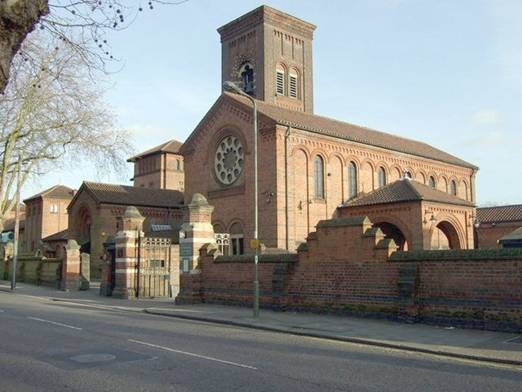
Figure 10. Golders Green
Crematorium, 62 Hoop Lane, London, NW11.
(Photograph courtesy of Wikipedia.com)
Johanna Louisa Annie Wade died in Stepney, London on the 4th of March 1957. She was buried in Shaldon, Devonshire.
ANNEX A
Figure 11. Map of the
movements of Lieutenant Wade and the 4th Company, Bengal Sappers and
Miners during the Burma campaign of 1885-6.
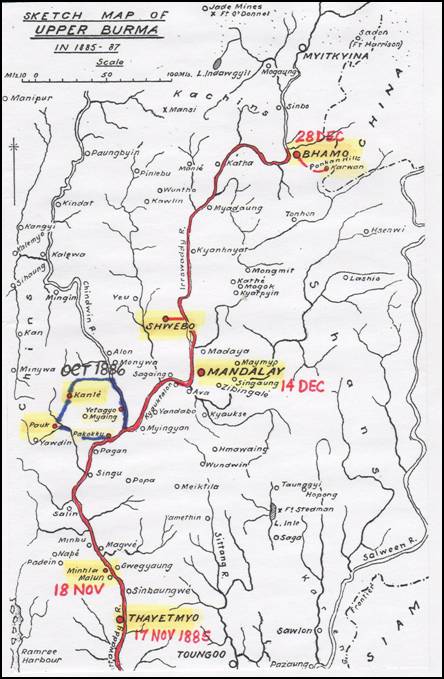
Royal Engineers and Indian Sapper and Miners That Took Part in the Burmese Expedition, 1885-1887.
As Major General H.N.D. Prendergast, VC was a Sapper, Engineer
representation in the campaign was good. The
key personnel and units involved consisted of the following:
Colonel G.E.L.S. Sandford, R.E.: Commander Royal Engineers: Awarded the CB
Lieutenant Colonel E.W. Begbie, R.E.: Director of Signalling
Major C.B. Wilkinson, R.E.: Adjutant
4th
Company, Bengal Sapper and Miners
Lieutenant W.A. Carnes, R.E. Lieutenant F.H. Kelly, R.E.
Lieutenant J.M Wade, R.E. Lieutenant F.J. Aylmer, R.E.
5th
Company, Bengal Sappers and Miners
Captain M.C. Barton, R.E. Lieutenant W.A.J. O’Meara, R.E. – wounded
Lieutenant J.W. Pringle, R.E.
“C”
Company, Madras Sappers and Miners
Captain A.R.F. Dorward, R.E.: Mentioned in Despatches and Distinguished Service Order
Lieutenant F.J. Anderson, R.E.: invalided
“D”
Company, Madras Sappers and Miners
Captain H.S. Andrews-Speed, R.E.
“H”
Company Madras Sappers and Miners
Captain J.M.T. Badgley, R.E. : invalided and died
Telegraph
Section
Lieutenant F. Glanville, R.E.:
wounded, Mentioned in Despatches and Distinguished Service Order
2nd
Company, Bombay Sappers and Miners
Captain J.D. Fullerton, R.E. Lieutenant H.V. Biggs, R.E.
Lieutenant C.E. Baddeley, R.E.
1st Madras Pioneers
The following officers of the Royal Engineers also served with the expedition. Many are shown in Figure 5 in the narrative.
Captain Alexander William Cockburn, R.E.: MID
Captain E.W. Cotter, R.E.
Lieutenant H.H. Barnet, R.E.: MID
Lieutenant C.D. Learoyd, R.E.: MID
Lieutenant J. Steward, R.E.: invalided
Lieutenant Beever C.N., R.E.: sick
Lieutenant T.F.B. Renny-Tailyour, R.E.: MID
Lieutenant W.R.Morton, R.E.
Lieutenant John Watson Pringle, R.E.
Lieutenant H.E. Goodwyn, R.E.: MID and DSO
Lieutenant Cyril Harcourt Roe, R.E.
Lieutenant R.T.R. Lawrence, R.E.
Lieutenant G. Palmer, R.E.: killed (died of wounds)
Lieutenant H.B.H. Wright, R.E.
Lieutenant H.G.C. Swayne, R.E.: invalided
Lieutenant John Anderson Dealey, R.E.: invalided
Lieutenant C.W. Ewbank, R.E.
Lieutenant L.P. Chapman, R.E.
Lieutenant J.A.S. Tulloch, R.E.
Lieutenant U.W. Evans, R.E.: invalided
Lieutenant Eliot Philipse Johnson, R.E.
Lieutenant G.R. Hutton, R.E.: invalided
Lieutenant C.H. Heycock, R.E.
Lieutenant T. Fraser, R.E.: invalided
Lieutenant C. Ainslie, R.E.
Lieutenant H.J.M. Marshall, R.E.
Lieutenant E.D. Bullen, R.E.
Lieutenant J.R.B. Sergeant, R.E.
Lieutenant A.E. Sandbach, R.E.
Lieutenant B.A. James, R.E.: killed
Lieutenant Joseph Cameron Rimington, R.E.
Lieutenant Ricardo Dartnell Petrie, R.E.
Lieutenant J.A. Tanner, R.E.
REFERENCES:
Army Lists
Books
1.
BOWIE, J. The
Empire at War. B.T. Bratsford
Limited, London, 1989, pp. 87-89.
2.
CHRISTISON, McC and HESTER, W.
Dulwich College War Records, 1914-1918. Dulwich College, first edition,
1923, p. 404.
3.
CONOLLY, T.W.J. Roll
of Officers of the Corps of Royal Engineers From 1660 to 1898.
The Royal Engineers Institute, Chatham, Kent, 1898.
ORMISTON, T.L. Dulwich College Register, 1619 – 1926, p. 124.
PARRITT, B.A.H. Red With Two Blue Stripes: The Story of the India General Service Medal, 1854. Charles A. Lusted, Tunbridge Wells, 1974.
SANDES, E.W.C. The Indian Sappers and Miners. The Institution of Royal Engineers, Chatham, Kent, 1948.
7. VIBART, H.M. Addiscombe, Its Heroes and Men of Note. A. Constable & Co., Westminster, 1884.
Census
1. 1871 Census of England (RG 10/2109).
2. 1881 Census of England (RG 11/748).
3. 1891 Census of England (RG 12/72).
4. 1901 Census of England (RG 13/2028).
5. 1911 Census of England and Wales.
6. 1939 England and Wales Register.
Certificates
Birth Certificate of James Molesworth Wade. Certified Copy of an Entry of Birth Given at the General Record Office, Certificate No. BXBZ 279105, dated 21st July 1992.
Death Certificate of Hender Molesworth St. Aubyn Wade. Certified Copy of an Entry of Death Given at the General Register Office, Certificate No. DXZ 079598, dated 21st July 1992.
Death Certificate of James Molesworth Wade. Certified Copy of an Entry of Death Given at the General Register Office, Certificate No. DXZ 178677, dated 21st February 1994.
Documents
Extract of the Will of Lieutenant Colonel James Molesworth Wade. Probate Registry, Somerset House, London.
Obituary of Lieutenant Colonel James Molesworth Wade. “The Times (London),’ Monday, 8 December 1930.
Statement of Services.
1903 Probate Calendar, p. 28.
1908 Probate Calendar, p. 118.
1911 Probate Calendar, p. 126.
1931 Probate Calendar, p. 218.
1986 Probate Calendar, p. 8526.
BBC letter to G.F. Wade, dated 23 May 1945, re: War Correspondent Service.
Family
Tree
James Molesworth Wade (et. al) by MParker5000
https://www.ancestry.com/family-tree/person/tree/32226092/person/19898055486/facts
Internet Web Sites
Historical Conversion of Currency
Old BBC Radio Broadcasting Equipment and Memories
The Peerage
Wikipedia: Francis Kelly (British Army Officer)
https://en.wikipedia.org/wiki/Francis_Kelly_(British_Army_officer)
Journals
Royal Engineers Journal, November 1921, p. 209.
Royal Engineers Journal, March 1923, pp. 136, 152 and 153.
Royal Engineers Journal, March 1925, p. 136.
Royal Engineers Journal, June 1925, pp. 335 and 336.
Royal Engineers Journal, December 1925, pp. 692 and 693.
Royal Engineers Journal, March 1926, pp. 158 and 159.
Royal Engineers Journal, June 1927, pp. 364 and 365.
London Gazette
The London Gazette, March 27, 1857, p. 1136.
The London Gazette, August 8, 1882, p. 3690.
The London Gazette, January 16, 1891, p. 291.
The London Gazette, February 20, 1900, p. 1172.
The London Gazette, October 26, 1900, pp. 6547 and 6548.
The London Gazette, 3 January 1911, p. 35.
The London Gazette, 5 January 1912, p. 130.
The London Gazette, 24 October 1922, p. 7470.
Medal Rolls
WO 100/69:
Medal Roll, Bengal Sappers and Miners, Burma 1885-87.
Periodicals
McINNES, I.
Reporting on Medals: Wearing Their
Crimean Medals. “Fighting
Forces” magazine, Volume 1, Number 3, January/February 1988.
Personal Communications
ALEXANDER, D.D. King George V’s Own Bengal Sappers and Miners. Letter dated 7 December 1993.
ALEXANDER, D.D. King George V’s Own Bengal Sappers and Miners. Letter dated 24 January 1994.
ALEXANDER, D.D. King George V’s Own Bengal Sappers and Miners. Letter dated 18 April 1994.
FARRINGTON, J. Letter dated 16 September 1992.
GIBBONS, Doctor J.
Letter dated 28 November 1993.
Royal Engineers Library, Note dated 31 January 1994, including
a. Statement of the Services of the Late Lieutenant Colonel J.M. Wade, R.E.
b. Unidentified document dated February 1931 showing a brief outline of the services and date of death.
Royal Engineers Lists
Royal Engineers Monthly Lists, 1905, January through December.
Royal Engineers Monthly Lists, 1908, January through December.
Royal Engineers Monthly Lists, 1910, January through December.
[i] Family tree and The Peerage.
[ii] The London Gazette, March 27, 1857, p. 1136.
[iii] Hart’s Army List, 1901.
[iv] Birth Certificate.
[v] Family tree and Dulwich College Register.
[vi] Dulwich College Register.
[vii] Ibid.
[viii] James may not have been in training at the School of Military Engineering for all of those two and a half years. Following his training he may have been posted to a unit at Chatham.
[ix] Later, Captain. Deceased 19 April 1903.
[x]
Kelly was commissioned into the Royal Engineers as a Lieutenant on 6 April
1879. He took part in the Burma expedition in 1885, was promoted to Captain
on 1 April 1889, and then went to the North West Frontier in India in 1897
where he participated in the Tirah Campaign, during which he was promoted to
Major on 1 October 1897. Following
the campaign he received a brevet promotion to Lieutenant-Colonel on 20 May
1898. He was appointed temporary
assistant adjutant-general in Quetta District on 23 June 1900 (while the
actual A.A.G. served in the Boxer Rebellion in China), serving as such for
several years. He was further appointed Commander of the Karachi Brigade in
1905 and Commander of the Ahmednagar Brigade in 1907.[1]
After that he became Commander of British Troops in South China in 1913 and
General Officer Commanding 69th (2nd East Anglian) Division in November 1915
during the First World War before retiring in 1918.After the War he became a
Regional Director at the Ministry of Pensions.
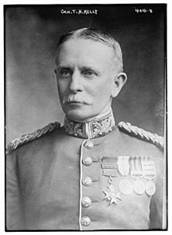
Figure
12. Major General Francis Henry
Kelly, CB, CMG.
(Photograph
courtesy of Wikipedia)
[xi]
Sir Harry North Dalrymple Prendergast. Prendergast
was 23 years old and a lieutenant in the Madras Sappers, Madras Army during
the Indian Rebellion of 1857 when the following deed took place for which he
was awarded the VC: For conspicuous bravery on the 21st of November, 1857,
at Mundisore, in saving the life of Lieutenant G. Dew, 14th Light Dragoons,
at the risk of his own, by attempting to cut down a valaitee, who covered
him (Lieutenant Dew) with his piece, from only a few paces to the rear.
Lieutenant Prendergast was wounded in this affair by the discharge of the
piece, and would probably have, been cut down, had not the rebel been killed
by Major Orr. He also distinguished himself by his gallantry in the actions
at Ratgurh and Betwa, when he was severely wounded. Major-General Sir Hugh
Rose, in forwarding his recommendation of this Officer, states:
"Lieutenant Prendergast, Madras Engineers, was specially mentioned by
Brigadier, now Sir Charles Stuart, for the gallant act at Mundisore, when he
was severely wounded; secondly, he was specially mentioned by me when acting
voluntarily as my Aide-de-Camp in the Action before besieging Ragurh, on the
Beena river, for gallant conduct. His horse was killed on that occasion.
Thirdly, at the Action of 'the Betwa', he again voluntarily acted as my
Aide-de-Camp, and distinguished himself by his bravery in the charge, which
I made with Captain Need's Troop, Her Majesty's 14th Light Dragoons, against
the left of the so-called Peishwa's Army, under Tantia Topee. He was
severely wounded on that occasion." He received his VC from Queen
Victoria at the Quadrangle of Windsor Castle on 4 January 1860 along with
twenty-four other recipients of the decoration.
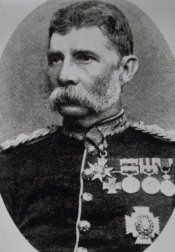
Figure
13. Sir Harry North Dalrymple
Prendergast, CB, VC.
(Photograph courtesy of Wikipedia)
[xii] In 1885, the French consul M. Hass moved to Mandalay and negotiated the establishment of a French Bank in Burma, a concession for a railway from Mandalay to the northern border of British Burma and a French role in running monopolies controlled by the Burmese government.
[xiii] SANDES.
[xiv] Later, Lieutenant General, VC, KCB. Deceased 3 September 1935.
[xv] Dulwich College Register.
[xvi] Later, General Sir Bindon Blood, GCB, GCVO. Deceased, 16 May 1940.
[xvii] Medal roll.
[xviii] The London Gazette, 16 January 1891.
[xix] Hart’s Army Lists, 1892, p. 211 and 1895, p. 210.
[xx] Statement of Service.
[xxi] Ibid.
[xxii] Ibid.
[xxiii] The London Gazette, 20 February 1900.
[xxiv] Statement of Service.
[xxv] CMG on 1 January 1918.
[xxvi] Royal Engineers Lists, March and April 1905, p. v.
[xxvii] Ibid., May 1905, p. xxix.
[xxviii] Later, Brigadier General.
[xxix] Royal Engineers List, September 1908, p. iv.
[xxx] Deceased, 21 March 1920. https://www.findagrave.com/memorial/104808274/harold-frank-chesney
[xxxi] Royal Engineers List, September 1908, p. iv.
[xxxii] Ibid.
[xxxiii] The London Gazette, 5 January 1912.
[xxxiv] Hart’s Army List, 1898, p. 746.
[xxxv] 1908 Probate Calendar.
[xxxvi] Historical Conversion of Currency.
[xxxvii] 1911 Probate Calendar.
[xxxviii] Dulwich College Register.
[xxxix] Hart’s 1901 Army List.
[xl] Death certificate.
[xli] Death Certificate.